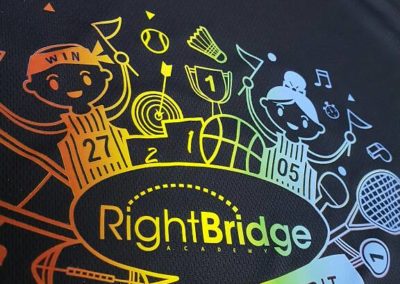T-shirt HD Printing (CMYK)
There is often confusion when customers come to us with full color artwork expecting that we can print it with 4 colors on any garment color when the reality is often quite different. 4 Color Process (also known as CMYK) printing was developed to reproduce full-color artwork accurately when printed on white paper. Essentially, a decent sized gamut of visible color can be represented by printing various densities of the primary colors Cyan, Magenta, Yellow and Black.
Indeed, this typically works great on paper and on-screen, but getting the image onto fabric can be an entirely different beast. Our limitations with this process are mostly due to substrate thickness, flexibility and color.
The CMYK color model was developed to work against a white background which is rarely a problem with paper. Garments on the other hand come in a wide variety of colors. For CMYK to work on a fabric color other than a very light one like white or natural, then we need to usually add at least 2 colors to make it work close to what is expected. These 2 additional colors are usually both white. One will be for the underbase plate, printing an opaque white down first to provide the white backdrop that CMYK colors need to work. CMYK inks are usually more transparent than typical inks, allowing the overlap of colors to create all of the various tones of the image. Because of this, we need to have a white underbase to lay the transparent inks on top of. Since an underbase plate is rarely opaque enough to be a bright white, we will need a second white screen to add white into the brightest areas of the image. All of the sudden, our 4 color print has become a 6 color print.
But wait, there are more complications in store! Unlike paper, fabrics are prone to varying in thickness due to their flexibility and the fact that they are made in various factories across the world and by humans with varying standards and methods. Slight variances in thickness cause some garment surfaces to be closer to the screen than others. These variances can translate into more-saturated prints on thicker fabric and sometimes color shifts where the entire image takes on a slight tint of Magenta, Yellow, Cyan or Black.
That all being said, CMYK printing is still a useful method for a number of projects. We prefer to use this on white or very light garments when the artwork consists of an image that does not contain colors that need to be exact, and on images where there are not many “memory colors”. We define a “memory color” as a color that we intuitively know when it is wrong. For example, skin tones, the color of the sky and foliage are all such colors that we notice if they are even slightly off.
Based on these limitations, we’ve found that CMYK is most appropriate for printing images that are:
- Cartoony or fantastic graphics.
- Washed out or distressed full color graphics.
- Full Color on a budget where accurate reproduction isn’t as important.
- Heavily processed or saturated images where memory colors have already been tweaked.



